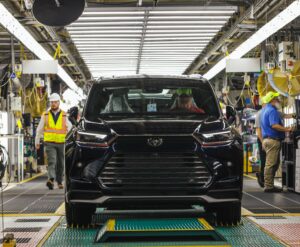
Toyota commits $11M to supporting STEM in Indianapolis
By onAnnouncements
Toyota says it will donate up to $11.1 million to Indiana schools to help prepare students for science, technology, engineering and math (STEM) careers.
It announced the gift donation, being made through its Driving Possibilities initiative, to mark the start of production on its inaugural Grand Highlander.
The new model features a number of advanced driver assistance systems, including a pre-collision system with pedestrian detection, radar cruise control, lane departure assist and lane tracing assist.
Other features include road sign assist to detect things like speed and yield signs, automatic high beams and proactive driving assist.
The automaker said initial Driving Possibilities funds will be used to support access to pre-kindergarten, mental health, multi-language learning and STEM programs for both students and teachers.
“Toyota is always looking to the future, by introducing new products like the Grand Highlander, and innovative community initiatives like Driving Possibilities,” said Toyota Indiana president, Leah Curry. “Driving Possibilities sets the foundation for powerful learning experiences to prepare area students for future STEM careers.”
Toyota announced its $110 million Driving Possibilities initiative last year to “prepare youth for the careers of tomorrow.”
It’s the largest and most comprehensive program in the OEM’s history.
When celebrating Grand Highlander production beginning earlier this month, Indiana Gov. Eric J. Holcomb noted how benefits will expand beyond the assembly line.
“We also celebrate Toyota’s continued contribution in early learning programs, which will further help strengthen investments we’re making across the state and set the stage for some of our youngest Hoosiers to pursue a future in STEM,” Holcomb said.
Although Driving Possibilities is not intended to directly support collision repair jobs, Support for trades careers is necessary to help fill a talent gap within a number of industries.
A Techforce study found that while 232,000 techs were needed in 2021 across automotive, diesel, and collision repair, schools were graduating only 42,000. In collision alone, the demand was 35,000 techs while only 4,500 graduated.
“Our goal is to increase awareness of future STEM careers while helping build sustainable programs in the communities where our Toyota team members live and work,” said Tellis Bethel, Toyota’s group vice president of social innovation. “It’s exciting to see the expansion of Driving Possibilities near our Toyota Indiana plant with up to $4.2 million in the first year and more in years to come.”
A 2022 survey commissioned by the Collision Engineering Program (CEP) indicated that there is a lack of awareness about collision repair careers, although people are open to exploring them. It found just 17% of survey respondents were “very familiar” with collision repair or engineering. The survey revealed that those who were familiar with the industry were more likely to pursue a career within it.
It also found that respondents with less than 10 years of work experience are more likely to switch their careers to collision engineering when compared to others who’ve worked in a separate industry for more than a decade.
The Universal Technical Institute is also helping bridge the gap through a number of initiatives. Its Q2 results this year exceeded expectations with generated revenue of $163.82 million, beating estimates by nearly $11 million, according to a Best Stocks report.
“This robust revenue growth can be attributed to several factors, including increased demand for skilled technicians in the transportation industry, successful implementation of strategic initiatives to enhance student outcomes, and effective cost management strategies,” the outlet said.
Meanwhile, the Collision Repair Education Foundation announced earlier this month that its annual fundraiser raised more than $100,000 to support collision repair programs, schools and students nationwide.
“Funds raised from this event allow CREF to continue supporting high school and college collision programs, students, and instructors across the country,” said CREF executive director Brandon Eckenrode.
The winning team – from Certified Collision Group – consisted of Bob Cornelius, Steve Widen and Stan Wassell.
Images
Main image: A Grand Highlander is pictured rolling down an Indianapolis assembly line/Courtesy of Toyota
